 W
WRoman technology is the collection of techniques, skills, methods, processes, and engineering practices utilized and developed by the civilization of ancient Rome .The Roman Empire was a technologically advanced civilization of antiquity. The Romans incorporated technologies from the Greeks, Etruscans, and Celts. The technology developed by a civilization is limited by the available sources of energy, and the Romans were no different in this sense. Accessible sources of energy determine the ways in which power is generated. The main types of power accessed by the ancient Romans were human, animal, and water.
 W
WAir conditioning is the process of removing heat and moisture from the interior of an occupied space to improve the comfort of occupants. Air conditioning can be used in both domestic and commercial environments. This process is most commonly used to achieve a more comfortable interior environment, typically for humans and other animals; however, air conditioning is also used to cool and dehumidify rooms filled with heat-producing electronic devices, such as computer servers, power amplifiers, and to display and store some delicate products, such as artwork.
 W
WA bellows or pair of bellows is a device constructed to furnish a strong blast of air. The simplest type consists of a flexible bag comprising a pair of rigid boards with handles joined by flexible leather sides enclosing an approximately airtight cavity which can be expanded and contracted by operating the handles, and fitted with a valve allowing air to fill the cavity when expanded, and with a tube through which the air is forced out in a stream when the cavity is compressed. It has many applications, in particular blowing on a fire to supply it with air.
 W
WA bookcase, or bookshelf, is a piece of furniture with horizontal, shelves, often in a cabinet, used to store books or other printed materials. Bookcases are used in private homes, public and university libraries, offices and bookstores. Bookcases range from small, low models the height of a table to high models reaching up to ceiling height. Shelves may be fixed or adjustable to different positions in the case. In rooms entirely devoted to the storage of books, such as libraries, they may be permanently fixed to the walls and/or floor.
 W
WCameo is a method of carving an object such as an engraved gem, item of jewellery or vessel. It nearly always features a raised (positive) relief image; contrast with intaglio, which has a negative image. Originally, and still in discussing historical work, cameo only referred to works where the relief image was of a contrasting colour to the background; this was achieved by carefully carving a piece of material with a flat plane where two contrasting colours met, removing all the first colour except for the image to leave a contrasting background.
 W
WA central heating system provides warmth to the whole interior of a building from one point to multiple rooms. When combined with other systems in order to control the building climate, the whole system may be an HVAC system.
 W
WIn cutlery or kitchenware, a fork is a utensil, now usually made of metal, whose long handle terminates in a head that branches into several narrow and often slightly curved tines with which one can spear foods either to hold them to cut with a knife or to lift them to the mouth.
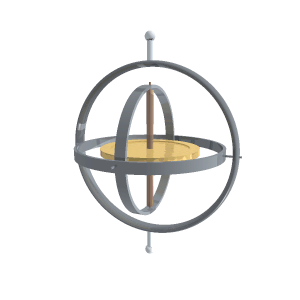 W
WA gimbal is a pivoted support that allows the rotation of an object about a single axis. A set of three gimbals, one mounted on the other with orthogonal pivot axes, may be used to allow an object mounted on the innermost gimbal to remain independent of the rotation of its support. For example, on a ship, the gyroscopes, shipboard compasses, stoves, and even drink holders typically use gimbals to keep them upright with respect to the horizon despite the ship's pitching and rolling.
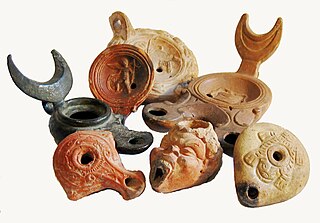 W
WAn oil lamp is an object used to produce light continuously for a period of time using an oil-based fuel source. The use of oil lamps began thousands of years ago and continues to this day, although their use is less common in modern times.
 W
WPig iron is an intermediate product of the iron industry in the production of steel, also known as crude iron, which is obtained by smelting iron ore in a blast furnace. Pig iron has a very high carbon content, typically 3.8–4.7%, along with silica and other constituents of dross, which makes it very brittle and not useful directly as a material except for limited applications.
 W
WThe Ancient Romans developed the Roman hand abacus, a portable, but less capable, base-10 version of earlier abacuses like those used by the Greeks and Babylonians. It was the first portable calculating device for engineers, merchants and presumably tax collectors. It greatly reduced the time needed to perform the basic operations of arithmetic using Roman numerals.
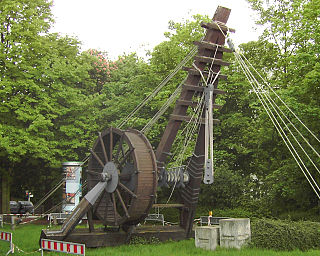 W
WThe ancient Romans were famous for their advanced engineering accomplishments. Technology for bringing running water into cities was developed in the east, but transformed by the Romans into a technology inconceivable in Greece. The architecture used in Rome was strongly influenced by Greek and Etruscan sources.
 W
WRoman glass objects have been recovered across the Roman Empire in domestic, industrial and funerary contexts. Glass was used primarily for the production of vessels, although mosaic tiles and window glass were also produced. Roman glass production developed from Hellenistic technical traditions, initially concentrating on the production of intensely coloured cast glass vessels. However, during the 1st century AD the industry underwent rapid technical growth that saw the introduction of glass blowing and the dominance of colourless or 'aqua' glasses. Production of raw glass was undertaken in geographically separate locations to the working of glass into finished vessels, and by the end of the 1st century AD large scale manufacturing resulted in the establishment of glass as a commonly available material in the Roman world, and one which also had technically very difficult specialized types of luxury glass, which must have been very expensive.
 W
WA salt mine is a mine from which salt is extracted. The mined salt is usually in the form of halite, and extracted from evaporite formations.
 W
WA sawmill or lumber mill is a facility where logs are cut into lumber. Modern sawmills use a motorized saw to cut logs lengthwise to make long pieces, and crosswise to length depending on standard or custom sizes. The "portable" sawmill is of simple operation. The log lies flat on a steel bed, and the motorized saw cuts the log horizontally along the length of the bed, by the operator manually pushing the saw. The most basic kind of sawmill consists of a chainsaw and a customized jig, with similar horizontal operation.
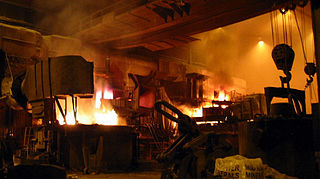 W
WSteelmaking is the process of producing steel from iron ore and/or scrap. In steelmaking, impurities such as nitrogen, silicon, phosphorus, sulfur and excess carbon are removed from the sourced iron, and alloying elements such as manganese, nickel, chromium, carbon and vanadium are added to produce different grades of steel. Limiting dissolved gases such as nitrogen and oxygen and entrained impurities in the steel is also important to ensure the quality of the products cast from the liquid steel.
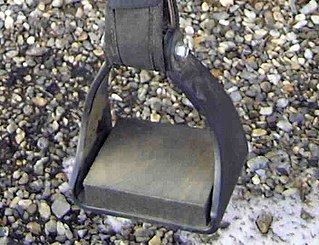 W
WA stirrup is a light frame or ring that holds the foot of a rider, attached to the saddle by a strap, often called a stirrup leather. Stirrups are usually paired and are used to aid in mounting and as a support while using a riding animal. They greatly increase the rider's ability to stay in the saddle and control the mount, increasing the animal's usefulness to humans in areas such as communication, transportation and warfare.
 W
WSunglasses or sun glasses are a form of protective eyewear designed primarily to prevent bright sunlight and high-energy visible light from damaging or discomforting the eyes. They can sometimes also function as a visual aid, as variously termed spectacles or glasses exist, featuring lenses that are colored, polarized or darkened. In the early 20th century, they were also known as sun cheaters.
 W
WAn urn is a vase, often with a cover, with a typically narrowed neck above a rounded body and a footed pedestal. Describing a vessel as an "urn", as opposed to a vase or other terms, generally reflects its use rather than any particular shape or origin. The term is especially often used for funerary urns, vessels used in burials, either to hold the cremated ashes or as grave goods, but is used in many other contexts; in catering large vessels for serving tea or coffee are often called "tea-urns", even when they are metal cylinders of purely functional design. Large sculpted vases are often called urns, whether placed outdoors, in gardens or as architectural ornaments on buildings, or kept inside.